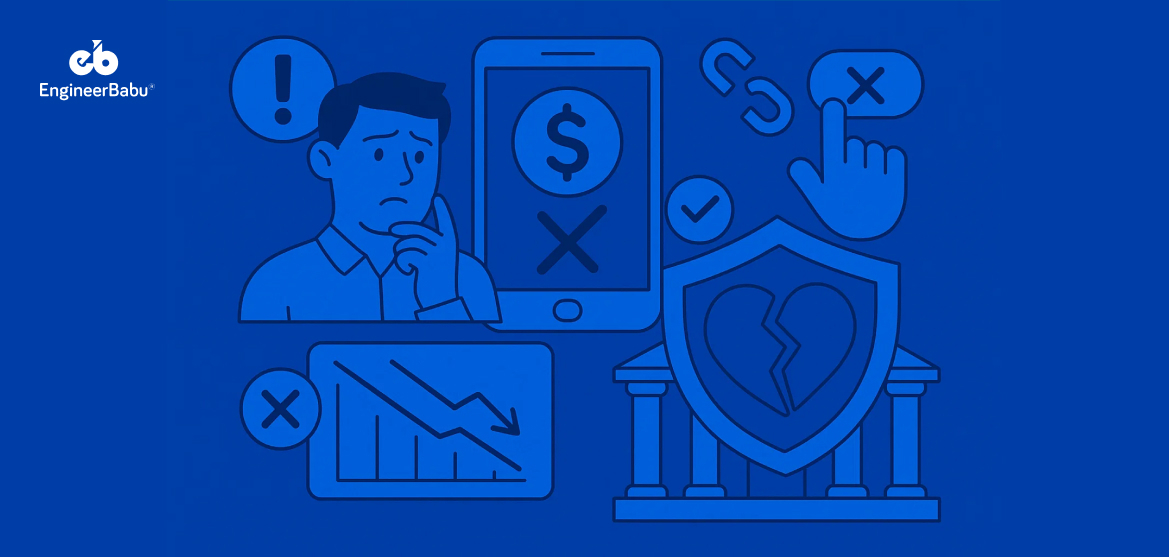Trust is at the heart of every fintech product. When people let an app handle their money, they expect clarity, confidence, and ease, anything less breaks that bond. And unfortunately, UX mistakes in fintech can shatter trust faster than hacks or headlines.
Take onboarding, for example. According to Gitnux, around 60% of users abandon a fintech platform because the onboarding process is overly complicated. That means more than half of potential customers never make it past step one, not because they don’t need the service, but because the experience feels frustrating or unclear.
It’s more than lost conversions, it’s the sense that the brand doesn’t respect or understand users’ time and concerns. In fintech, cluttered menus or confusing flows aren’t just annoying, they feel risky.
Therefore, this blog dives into five UX mistakes in fintech that damage trust. From onboarding hurdles to accessibility gaps, each misstep weakens confidence in a brand. Let’s break down these mistakes and explore how to avoid them.
Common UX Mistakes in Fintech That Kill Trust
Even the most secure fintech platform can lose customers if the experience feels clunky or confusing. Users want financial tools that are not only safe but also effortless to navigate.
Below are some of the most common UX mistakes in fintech that silently chip away at trust and credibility.
Mistake 1: Complicated Onboarding and KYC Processes
The first experience sets the tone for how users perceive a fintech app. If onboarding feels like a maze, trust takes a hit right away. People are willing to share sensitive data, but not if the process feels confusing or unnecessarily drawn out.
Where many fintech apps go wrong:
- Asking for excessive personal details at once.
- Presenting KYC steps with little to no context.
- Using long forms without progress indicators.
- Offering no feedback when documents are uploaded or rejected.
Better approaches to build confidence:
- Break the process into smaller, guided steps.
- Use tooltips or short notes to explain why data is required (e.g., fraud prevention).
- Show a clear progress bar so users know how far they’ve come.
- Provide instant validation when IDs or documents are submitted.
Example: A P2P payment app that reduced its KYC form from 12 fields to 5 essential ones saw completion rates jump significantly because users felt the process respected their time.
Avoiding such UX mistakes in fintech not only reduces abandonment but also builds a foundation of trust from the first interaction.
Mistake 2: Overwhelming Dashboards and Poor Information Hierarchy
Fintech apps often try to show everything at once, like balances, spending graphs, investment options, and notifications. The result is a crowded dashboard where users can’t figure out what to focus on. When money is involved, confusion quickly translates into distrust.
Typical mistakes that overwhelm users:
- Showing too many features on the home screen.
- Using small fonts or poor spacing that hides key details.
- Placing important actions (like transfers) behind secondary menus.
How to make dashboards user-friendly:
- Prioritise essentials such as account balance, recent transactions, and alerts.
- Use visual hierarchy, bigger text for key numbers, smaller for secondary info.
- Allow users to personalise what they see first.
Example: A digital wallet that moved “Send Money” to the top of the dashboard saw a sharp increase in repeat usage, because users could act quickly without searching.
Mistake 3: Lack of Transparency in Security Features
Security is the backbone of fintech trust. If users don’t see signs that their money is safe, they feel exposed. Some apps hide security steps behind confusing flows or don’t communicate how protection works, which can raise suspicion.
Red flags that reduce trust:
- OTP screens without clear confirmation messages.
- Hidden encryption indicators during transactions.
- No visible reminders of fraud protection policies.
Ways to improve trust through transparency:
- Show security icons or lock badges during sensitive actions.
- Use plain language to explain protections (e.g., “Your data is encrypted”).
- Send notifications after every login or transaction.
Example: A neobank introduced simple in-app alerts for each login attempt, which reassured customers and cut support calls related to security fears. Avoiding such UX mistakes in fintech makes every interaction feel seamless and trustworthy.
Mistake 4: Inconsistent Design and Navigation Patterns
When buttons, colours, or flows change from one section to another, users feel like they’re using multiple apps stitched together. This inconsistency causes hesitation and hesitation in fintech means doubt about safety.
Common inconsistencies:
- Different button styles for the same action.
- Menus shifting between screens.
- Inconsistent terminology (“wallet” in one section, “funds” in another).
Fixing design consistency:
- Adopt a design system with clear rules for typography, colours, and components.
- Keep navigation predictable, especially for core actions like transfers.
- Test flows with real users to catch friction points.
Example: A stock trading app unified its terminology and colour scheme across mobile and web. User surveys later showed higher satisfaction and greater confidence in transactions.
Mistake 5: Ignoring Accessibility and Mobile Responsiveness
Fintech serves a wide audience, from students managing budgets to seniors checking pensions. When accessibility is ignored, large groups of users feel excluded. Poor responsiveness or unreadable text creates unnecessary frustration.
Accessibility pitfalls:
- Tiny buttons that are hard to tap on mobile.
- Low colour contrast that makes text unreadable.
- No support for screen readers.
Inclusive improvements that build trust:
- Use responsive layouts that adapt to all devices.
- Apply accessible colour palettes with strong contrast.
- Ensure all actions can be completed with assistive technologies.
Example: A bank redesigned its app with larger tap targets and core banking solutions. This not only improved usability for older customers but also boosted overall customer ratings. Addressing these UX mistakes in fintech shows commitment to inclusivity and user respect.
Conclusion
Trust in fintech is built on more than compliance or security, it’s shaped by every tap, click, and interaction. Complicated onboarding, cluttered dashboards, unclear security cues, inconsistent design, and accessibility gaps are all small cracks that can grow into major trust issues if left unchecked.
By addressing these areas, fintech companies not only reduce user frustration but also create products people feel safe relying on every day.
If you’re building or scaling a fintech product, the right design partner can make the difference between users who churn and users who stay. At EngineerBabu, we specialise in crafting seamless, intuitive, and trust-focused digital experiences.
Explore our expert fintech app development services to create fintech solutions that customers trust and love to use.
FAQs
Why is UX so important in fintech apps?
UX directly impacts how users perceive safety and reliability. In fintech, where people share sensitive data and manage money, even small design flaws can feel risky. A clear, intuitive experience reassures users that their financial transactions are secure and the company is trustworthy.
What are the most common UX mistakes in fintech apps?
Some of the biggest issues include long or confusing onboarding, dashboards that overwhelm users with information, unclear security cues, inconsistent navigation, and ignoring accessibility. Each of these weakens trust and pushes users toward competitors with smoother experiences.
How can fintech companies improve the onboarding process?
Keep sign-ups simple and transparent. Break down steps into smaller chunks, explain why information is needed, and show progress indicators. Offering real-time validation for document uploads also helps reduce friction and reassures users during KYC.
What role does accessibility play in fintech UX?
Accessibility ensures that everyone, including people with disabilities, can use the app without barriers. This means readable fonts, proper colour contrast, large tap targets, and compatibility with screen readers. Prioritising accessibility is not just inclusive, it also expands the customer base.
How can EngineerBabu help fintech brands avoid UX mistakes?
EngineerBabu’s team specialises in designing fintech experiences that prioritise trust, clarity, and ease of use. Through tailored UI/UX design services, we help fintech companies build products that meet compliance needs while keeping users engaged and confident.




